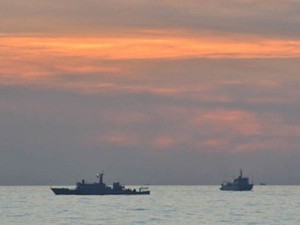
Chinese surveillance ships are seen off Scarborough Shoal in his undated file photo taken by the Philippine Navy and released by the Department of Foreign Affairs. AFP/DFA
The Philippine military on Thursday expressed elation over the plan of the United States to provide the country with a powerful radar system to help deter intrusions in the West Philippine (South China) Sea.
The Armed Forces of the Philippines (AFP) in a statement said that such a system would help the country form a “minimum credible defense posture” in the midst of a territorial dispute with China over Panatag (Scarborough) Shoal and other islands.
“This significant development comes at a very opportune time as we try to beef up our defenses, particularly our maritime surveillance capabilities,” said AFP public affairs chief Colonel Arnulfo Marcelo Burgos Jr.
Transnational crime
Burgos said “this effort will not only help us prevent foreign intrusions but will also aid us in addressing transnational crimes like poaching, human trafficking, piracy and drug trafficking.”
On Tuesday, a Pentagon spokesperson announced plans by the United States to provide the Philippines with a powerful land-based radar system that would form part of a Coast Watch Center that would track ship movements off the archipelago’s coastline.
“This center will improve Philippine maritime domain awareness on a breadth of security issues, including countering the proliferation of WMD (weapons of mass destruction) and illegal smuggling,” US Major Catherine Wilkinson had earlier told Agence France-Presse.
The Philippines has been seeking military assistance from the United States, its closest ally, to boost its position in its long-running quarrel with China over Panatag Shoal and other islands.
Panatag standoff
In April, tensions rose after Philippine authorities tried to arrest Chinese fishermen at Panatag who were ripping up the coral and catching banned fish species.
The standoff continued well into May while the Department of Foreign Affairs and its Chinese counterpart sought a diplomatic resolution.
The leftist group Bagong Alyansang Makabayan (Bayan), meanwhile, said the US had long been pushing for a surveillance system in the Philippines “to allow it to have control over vital sea lanes such as the South China Sea.”
“If the plan pushes through, the US will have set up its own spy base on Philippine territory disguised as a coast watch center and in clear violation of Philippine sovereignty,” said Bayan secretary general Renato Reyes Jr. in a statement.
Surveillance system
He said a maritime surveillance system had been proposed since the administration of Gloria Macapagal-Arroyo when Kristie Kenney was the US ambassador.
Reyes cited a diplomatic cable dated Aug. 27, 2007—one of the thousands of US memos leaked by cyber whistle-blower WikiLeaks—that showed the US embassy in Manila proposing an elaborate regional surveillance network to further advance US maritime security efforts.
“Our proposal emphasizes the installation of land-based and sea-based maritime radar and other types of surveillance and identification equipment in the tri-border area of Malaysia, Indonesia and the Philippines, and other key points between Sri Lanka and the Philippines, to monitor vessels suspected of carrying terrorists, weapons or drugs, as well as those engaged in human trafficking and other illegal activities,” the unverified cable read in part. With a report from Jerry E. Esplanada